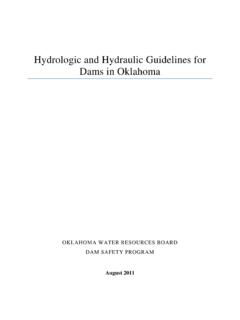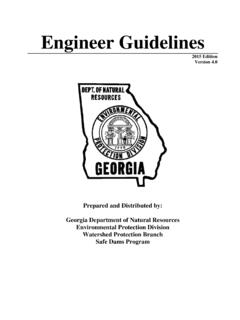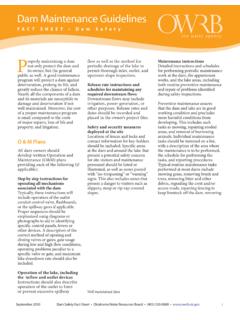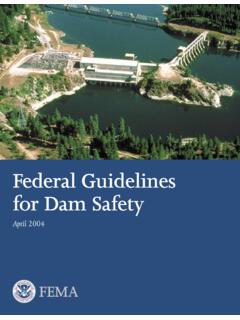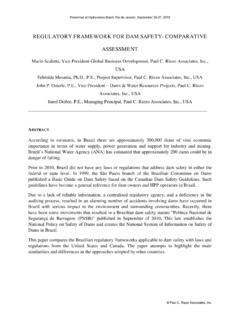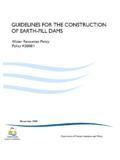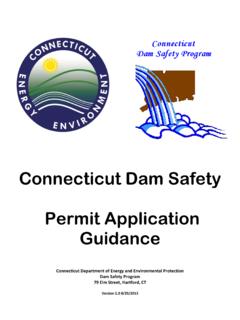Transcription of Dam Safety Management System (SMS)
1 Dams Safety Committee NEW SOUTH WALES. DSC2A June 2010. DAM Safety Management System (SMS). Table of Contents Item Page 1. Introduction .. 2. 2. DSC Safety Management Goals & Key Requirements .. 2. 3. Background .. 4. 4. Requirements for Dam Safety Management System (SMS) .. 5. 5. Reporting to DSC on the Safety Management System (SMS) .. 6. 6. Safety Management System (SMS) which do not satisfy the DSC. Normal Requirement .. 10. 7. Reporting to DSC on Dams that do not, or may not, meet DSC. Safety Requirements .. 11. 8. Reporting to DSC of Dam Safety Incidents or Failures .. 13. 9. References .. 14. Appendix A Status of Safety Management System Reporting Form - 15. DSC2A Page 1 of 17. 1. INTRODUCTION. T he normal requirements of the Committee (DSC) are set out in with its principal guidance sheet, NSW Dams Safety its guidance sheets DSC Background, Functions and Operations - DSC1A, outlining the DSC's general operations and authority.
2 The DSC considers that a vital part of dam Safety Management programs is an effective Safety Management System (SMS). Accordingly, this sheet is provided for the guidance and direction of dam owners, and their consultants, in undertaking programs and actions in this area. However, dam owners, and their professional advisers, are reminded that they are responsible for the Safety of their dams and will own the liabilities for the Safety of their dams in the event risks are realised. The purpose of this guidance sheet is to provide the owners of prescribed, or proposed dams with general advice on the objectives and necessary elements of an effective Safety Management System and of the reporting needed by the DSC in that regard, along with specific advice on the owner's responsibilities and the requirements of the DSC in this area. The DSC Safety Management Goals and Key Requirements (Section 2) at the start of the sheet are a summary - the whole sheet is to be read for a proper understanding of DSC requirements for a dam Safety Management System .
3 2. DSC Safety Management GOALS AND KEY REQUIREMENTS. DSC Safety Management Goals T he DSC's primary goal, relevant to this guidance sheet, is that risks to community interests from the potential for dam failure are tolerable. This requires that the risks are. detected, identified and assessed;. reduced, when necessary, as soon as reasonably practicable and in a way that best serves community interests; and kept under review throughout the life cycle of the dam(s). To keep a continuous watch on risks there needs to be an effective Safety Management System (SMS) in place for each prescribed dam. That is the secondary goal of this guidance sheet. This sheet defines the DSC. requirements for an acceptable normal SMS. The DSC. will consider an alternative SMS provided the owner can demonstrate that it would reliably achieve the goals of this sub-section. Another goal is a risk Management approach that facilitates a whole of Government approach to public Safety .
4 DSC2A Page 2 of 17. The following sections of this sheet aim to provide direction and guidance to assist the owner in achieving these DSC goals. DSC Key This section is a summary of the key DSC requirements Requirements outlined in this sheet. Dam Safety Management System 1. The DSC requirement is that an owner will manage the risks of dam failure throughout the life of each dam by implementing an effective dam Safety Management System (SMS) (Sub-section ). 2. The normal SMS is based on the ANCOLD guidelines on Dam Safety Management , August 2003, subject to any variation set out in this and other DSC guidance sheets (Sub-section ). 3. An owner may propose an alternative SMS but would need to demonstrate to the satisfaction of the DSC that the System will achieve tolerable risks and maintain them over the life of the dam (Sub-section ). Dam Safety Management Flow Chart 1. The DSC normally expects that a Safety Management System will include the high level activities set out in Figure 1.
5 These activities are to ensure that any necessary improvements are made to achieve tolerable risks and that the risks from a dam are kept under review and properly managed over the whole dam life cycle (Sub-section ). Reporting to DSC on the Status of the Safety Management System 1. An owner is to report on the status of the dam Safety Management System for a dam by completing the form at Appendix A (DSC Form D12) and including it within the surveillance report (see DSC2C (Section 5). 2. For dams requiring a Type III report only certain items need be completed as indicated by the underlined parts in Section 5 and in Form D12 (Section 5). 3. The form does not need to be completed for intermediate reports (see DSC2C . Section 5). 4. Section 5 guides owners on DSC expectations for the normal Safety Management System based on ANCOLD (2003). The answers in Form D12 enable the DSC to judge the adequacy of the Safety Management System .)
6 5. Where an owner proposes an alternative SMS, which is accepted by the DSC, the owner is to submit an appropriate reporting form for consideration by the DSC (Section 5). Safety Management Systems which do not Satisfy the DSC Normal Requirements 1. If there are elements of the Safety Management System which do not satisfy the DSC. normal requirements, the normal expectation is that the owner would provide a program for actions that will achieve compliance. The alternatives are to apply to the DSC for a relaxation of particular requirements or to propose an alternative Safety Management System (Section 6). DSC2A Page 3 of 17. Reporting to DSC on Dams that do not or may not Meet DSC Safety Requirements 1. Upon becoming aware that the Safety of a dam or dams does not meet DSC. requirements or is uncertain, the owner is to provide a report to the DSC as soon as reasonably practicable (Section 7). 2. Thereafter reports are to be updated by 30 June each year until the DSC agrees that the Safety of the dam or dams is reliably known and no Safety deficiencies remain.
7 The purpose of reporting is to enable the DSC to see that deficiencies or uncertainties are being addressed as soon as reasonably practicable and to keep the DSC apprised of changes in the program of activities (Section 7). 3. Reporting is required at: y the individual dam level; and may be required at y the portfolio level (Section 7). Reporting to DSC of Dam Safety Incidents or Failure 1. Owners are to report Safety related incidents and failures to the DSC (Section 8). 2. Incident and failure reports will be treated confidentially in those respects set out in Section 8. 3. Upon an owner becoming aware of Safety incidents or failures, as described below, a report is to be provided to the DSC as soon as reasonably practicable if there are immediate or imminent implications for dam Safety (see DSEP requirements in DSC2G). or otherwise in the next surveillance report or intermediate report (Section 8). 4. If, in the opinion of the owner, the incident or failure requires investigation, a list of activities and time schedule are to be provided (Section 8).
8 3. BACKGROUND. T he principles of Safety Management in the developed countries have evolved in response to catastrophic accidents across all industries. Many of these accidents have resulted in large loss of life, extensive economic loss and permanent damage to ecosystems. A consistent theme to emerge from such experiences is the need to keep risks under review by a structured ongoing System of Safety Management that is supported by adequate human and financial resources. Some typical Safety Management principles from hazardous industry are outlined in documents which can be referenced from the DSC, including some requirements on Safety Management of dam Safety regulators in other states. The components of risk are potential failure events, the likelihood of each event and the adverse consequences should the event occur. As with other industries, the focus of dam Safety Management systems is the potential consequences, as there could be potential System vulnerabilities, which have gone unrecognized.
9 Part of the purpose of Safety Management systems is the timely detection of such unexpected vulnerabilities. By DSC2A Page 4 of 17. comparison with likelihood, the potential consequences are more readily identified. Thus if a System has potentially catastrophic consequences there is a stringent Safety Management System regardless of the perceived likelihood of those consequences being realized. On the other hand if the potential consequences are slight there is a much less demanding Safety Management System (SMS). The DSC will consider less stringent Safety Management at times when the potential consequences of System failure are reduced upon the owner making a supporting case to the DSC. Owners need to recognize that the quality and scale of the Safety Management System (SMS) needs to reflect the potential consequences of failure rather than the size of the dam. Small dams can be very lethal. The failures of Laurel Run Dam and Kelly Barnes Dam in the United States in 1977 resulted in the deaths of forty and thirty nine people respectively.
10 Laurel Run Dam was high and held 555ML of water at the time of failure. Kelly Barnes Dam was high and held 797ML at the time of failure. Small dams do not necessarily mean small consequences. As with all of the hazardous facilities on which society relies, for a dam it is a System that needs to have its Safety managed. Whilst the dam structure is the central element in that System , there are ancillary and wider sub- System elements such as: The operating personnel;. The decision and command personnel and processes;. Computers, software, monitoring and control sub- systems;. Flood warning and emergency response personnel and processes; and The complete range of dam Safety documentation and procedures. These are just a few examples of sub-systems that go to make up the total dam System . The Management of Safety needs to address all of the System sub-systems. 4. REQUIREMENTS FOR DAM Safety Management System (SMS).


